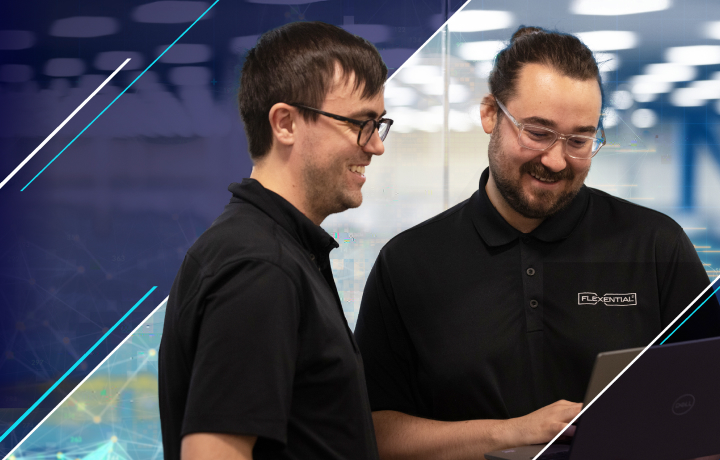Adapting IT for the new normal: Post-pandemic insights
Learn how IT roles are evolving post-pandemic to prioritize technology-driven connections and business enhancements.

As businesses move beyond the pandemic, it is clear that a lot has changed. Many of the digital transformations and business practices that companies adopted to survive the worldwide health threat are here to stay. That makes this year’s IT Professionals’ Day a fitting time to recognize and reflect on the IT professional’s role in keeping businesses operating during COVID-19 and in supporting the altered digital landscape the pandemic has left in its wake.
Accelerated digital transformations
While the IT role was far from routine or easy prior to the pandemic, it became increasingly pressure-filled and complex as workforces became more distributed and businesses relied on technology and robust networks more heavily than ever.
When COVID-19 struck, businesses were forced to instantly adapt their operations to support a remote workforce. Face-to-face business meetings and social interactions were replaced by video conferences. In-person doctor visits gave way to telehealth appointments. Even grocery shopping went digital. This instant shift placed new, more intense responsibilities on IT professionals, requiring them to quickly implement and then support a viable digital strategy—even if digital transformation was not in their organizations’ immediate plans. They also needed to support a suddenly remote—and in many cases, unprepared—workforce as it acclimated to the new work environment.
The mounting pressure of an always-on environment
The widespread reliance on a remote and highly distributed workforce made the resiliency and availability of the IT infrastructure more critical than ever before. Without access to critical systems, applications, data, and the corporate network, employees could not perform their jobs. Beyond work, people were relying on critical infrastructure in nearly every facet of their daily lives—from shopping to education to staying connected across the world with family and friends unable to travel. The pressure to deliver 100% uptime and keep technology operating effectively lay squarely on IT’s shoulders.
With employees working outside the structure of the office environment, troubleshooting issues to ensure unwavering availability became even more taxing as IT teams had to contend with home networks and other factors that were outside of the corporate IT environment. Having less insight into and control over this environment compounded the complexity of maintaining uptime.
The security game
The IT team also faced additional security challenges as employees were no longer working in a controlled office space. With less control over whether employees were securely accessing the corporate network, protecting confidential data, or following other security best practices, IT professionals faced greater security risks and a wider attack surface. This made safeguarding the corporate environment all the more difficult.
Communication takes center stage
Working outside of a central office puts a heightened focus on the effective communication of the IT team. Without ongoing, in-person collaboration and sharing, critical details that can impact IT performance and availability can slip through the cracks. Regular interaction between IT team members is key. While digital applications like Slack and Microsoft Teams enable and encourage this level of communication, maintaining detailed documentation on workflow changes, updated processes and system configurations, and other initiatives and responsibilities is critical to ensure everyone is on—and remains on—the same page.
Flexibility to work from anywhere
While this new, more virtual landscape placed a heavier burden on the IT team, it also offered conveniences that were largely unavailable pre-pandemic. The growing acceptance of hybrid work environments allows IT teams to leverage technology to untether them from the office and call center. IT teams can now remotely troubleshoot issues, monitor performance and conduct many other tasks to improve both time management and cost efficiency. This flexibility also empowers them to more quickly and effectively serve stakeholders when issues occur.
Building skill sets to serve emerging IT strategies
Technology changes quickly, and no one knows that better than an IT professional. Regularly connecting with colleagues and industry leaders to share insights and learn about emerging technologies, best practices, and industry direction is important to maintain cutting-edge skill sets and drive IT strategy. Online and hybrid training, leadership conferences, webinars, and other development opportunities provide the insight and instruction IT professionals need to advance their careers and support their companies’ strategic goals.
Appreciating the IT professional
The pandemic certainly highlighted the value IT professionals bring to their organizations. Post-pandemic, the IT role continues to evolve to focus less on staffing multiple support centers and more on using technology to create more opportunities to connect people, improve knowledge bases, and enhance the way companies conduct business.
At Flexential, we value our hundreds of data center specialists, including our Flexential Professional Services (FPS) team, our customer support team, and our IT and engineering teams, for the support and expertise they provide our business and our customers. These teams are integral to the availability and security of our infrastructure and the success of our FlexAnywhere® Solutions. Their expertise allows our customers to deploy solutions that improve application performance and reliability; easily scale and flex with evolving demands; and enable network connections and interconnections with public cloud, partners, and customers.
During the pandemic, our team helped customers navigate their digital transformations and ensure their businesses remained online and productive—and they continue to do so today.
Their tireless efforts enable our customers’ internal IT resources to devote more time to their core businesses rather than supporting infrastructure. We thank IT professionals for helping us achieve these results and for their continued commitment to taking on the business challenges that lay ahead.






